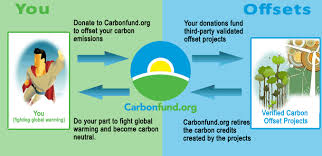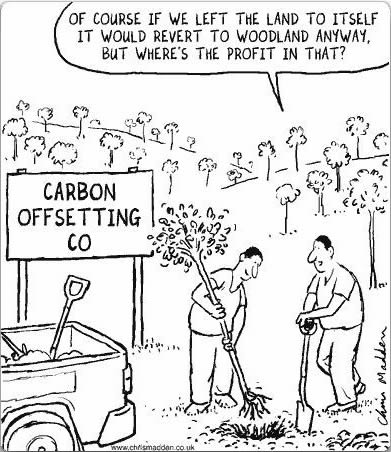Carbon offsets are a greenwashing mechanism that enables individuals to buy themselves green credentials without actually changing their consumption habits, and nations to avoid the more difficult structural and regulatory change necessary to prevent further global warming.
Carbon offset projects can include renewable energy projects, energy efficiency projects, projects that capture non-CO2 gases like methane, and biosequestration projects that absorb CO2 such as tree plantations. In 2012, 34% of the global voluntary offset market was for renewable energy projects and 32% was for biosequestration projects.

Offsets are often of dubious value in terms of genuine greenhouse gas reductions. For a start, because they are voluntary very few customers take them up, only about 5% in the case of airline passengers. However even if many more customers offset their air travel this would only be a token gesture of symbolic rather than significant greenhouse reduction.
Carbon offsets that capture methane can perpetuate existing health threats. An example is the way the operations of dangerous garbage dumps can be extended to earn offset money from methane gas extraction. Carbon offsets also provide an incentive for industrial facilities to be designed without pollution controls so that they present an attractive offset opportunity. It is conceivable, for example, that future landfill dumps in developing nations might be designed without methane capture in the hope that foreign investors looking for offsets would be attracted to pay for the methane capture.
By using carbon offsets, ‘a utility company releasing a million tonnes of carbon a year…can be just as “carbon-neutral” as a subsistence farming household emitting one tonne a year’. In this way the idea of carbon neutrality allows the very activities that contribute to global warming to continue unabated whilst promoting tree plantations that are often not environmentally beneficial (see below).
 Carbon offsets are also a way for corporations to green their image without making any real changes. In London, the black cabs are going ‘carbon neutral’ in an effort to forestall likely restrictions on polluting vehicles in the central London area. The black cabs are run on diesel which is particularly polluting. By contributing funds towards forestry projects in the UK and Germany, solar projects in Sri Lanka and a small hydro power plant in Bulgaria, polluting black cabs can be labelled as carbon neutral.
Carbon offsets are also a way for corporations to green their image without making any real changes. In London, the black cabs are going ‘carbon neutral’ in an effort to forestall likely restrictions on polluting vehicles in the central London area. The black cabs are run on diesel which is particularly polluting. By contributing funds towards forestry projects in the UK and Germany, solar projects in Sri Lanka and a small hydro power plant in Bulgaria, polluting black cabs can be labelled as carbon neutral.
Various firms are also offering their customers the opportunity to be ‘carbon neutral’ in some of their purchases. BP’s Global Choice program offers its commercial customers the choice of buying its Ultimate grade petrol with carbon offsets that are supposed to balance the greenhouse emissions released when the petrol is burned. To generate the offsets for its petrol, BP invested in a meat rendering plant near Sydney. Its investment enabled the plant to change its energy source from coal to gas, which creates less greenhouse gases. This annual reduction in greenhouse gases enables BP to  sell some of its petrol as ‘climate friendly’ and charge a premium for it.
sell some of its petrol as ‘climate friendly’ and charge a premium for it.
In 2007 Virgin Blue claimed to be Australia’s first “green airline” when it invited travellers to “contribute to a greener world” by paying to offset the emissions caused by their flights.
What is more, this form of carbon offsetting tends to shift the responsibility for greenhouse gas reductions onto individuals and away from the institutions, corporations and governments whose actions can make a real difference.
The scale of change that can be achieved by voluntary individual action is ‘entirely incommensurate with the problem of climate change’. For example in Australia, the greenhouse gases generated by individual travel is tiny compared with those caused by electricity generation and industry, and even those are overshadowed by the greenhouse gases generated by the coal exported from Australia.
The idea that people can negate their contribution to global warming (i.e. be carbon  neutral) by paying for enough trees to be planted is merely a way to take the guilt out of excessive and mindless consumerism and allow it to continue.
neutral) by paying for enough trees to be planted is merely a way to take the guilt out of excessive and mindless consumerism and allow it to continue.
Carbonfund.org promises individuals and businesses carbon offsets that will allow them to go on doing whatever they want with a clear conscience: ‘Whether you own a hybrid or a Hummer, now anyone can reduce their climate footprint to zero.’ All they have to do is pay the company the appropriate amount of money.
 Planting trees as offsets is particularly problematic. How many trees represent a ton of carbon dioxide emissions? What happens if the trees burn down in a forest fire and the stored carbon goes up in smoke? What happens to the carbon when the trees get old and die or are logged?
Planting trees as offsets is particularly problematic. How many trees represent a ton of carbon dioxide emissions? What happens if the trees burn down in a forest fire and the stored carbon goes up in smoke? What happens to the carbon when the trees get old and die or are logged?
Generally plantations are made up of single species, such as eucalyptus or pine, that grow quickly, have high fibre yield and can be easily logged. They suck up all the water in an area leaving wells dry, and the land around desiccated and unable to support crops. A report funded by the UK Forestry Research Programme found that they often lower water tables, draw water from the soil and drain rivers.
Another study found that when agricultural land in India were converted to forests there was a 16-26 percent reduction in water yields, partly because of the increased evaporation of water from the leaves.
Replacing grasslands with plantations – another common practice – can be equally counterproductive. Recent studies show that the Andean Paramos ecosystem, for example, is more efficient than tree plantations in absorbing CO2.
The trees are planted in rows of trees of the same age and species that require heavy use of agrichemicals, including fertilisers, chemical weeding, herbicides that pollute remaining waterways. Such plantations reduce soil fertility, increase erosion and compaction of the soil, and increase the risk of fire. In addition they may lead to a loss of biodiversity because they are monocultures of non-native species and because their densely packed uniform rows do not provide the variations of form and structure found in a forest.

Installing plantations of fast growing Australian eucalyptus on [Thailand’s] Baan Laan Kham swidden fields in order to ‘protect local watersheds’ has already had counterproductive effects. Native seedlings, saplings and other vegetation have had to be cleared to establish the plantations. Regeneration of native forest has been rendered impossible. Biodiversity has plummeted, and with it animal food supplies and carbon-storage capacity.
Where agricultural activities are displaced by plantations, forests may be cleared elsewhere to grow the food that would have been grown on the land now occupied by plantations. Also if carbon-credited forest protection projects cause the price of wood to rise, this will increase ‘pressures for logging outside project boundaries’.
US research suggests that the flux of carbon into forests is uncertain by a factor of two or three and annual variability as high as 100 per cent. For the continental US, sink estimates range between 0.2 and 1.3 billion tonnes per year and for Europe, between 0.2 and 0.4 billion tonnes. Canadian scientists have pointed out that uncertainty in estimates of the carbon balance in their country's forests could be greater than 1,000 percent if even seemingly small factors such as increased CO2 levels in the atmosphere are not taken into account.
In some cases, such as where plantations are located in wet areas of Finland, the loss of carbon from soils and the draining of peatlands outweighs the gain from the growing trees. Other factors that may counteract the gains from planting trees include the removal of ground cover and the effect of plantations on erosion and soils downstream. Even preparing an area for planting of trees can release large quantities of CO2 from the soil, and CO2 can also be generated by the manufacture of the agrichemicals to be used, and the machinery used to clear the site.
Timber eco-labels such as the Forest Stewardship Council certify plantation timber despite these problems.
There are no regulated standards for what counts as an offset and claimed offsets are often not independently audited.
 The Voluntary Gold Standard for carbon offsets does not include tree plantations or methane capture as acceptable offsets, only energy reduction or energy efficiency projects.
The Voluntary Gold Standard for carbon offsets does not include tree plantations or methane capture as acceptable offsets, only energy reduction or energy efficiency projects.
Even with these types of offsets, there is the problem of assessing whether the projects would not have been built anyway without someone paying for the offset. For example Climate Care financed the distribution of tens of thousands of fluorescent light bulbs in South African townships as carbon offsets shortly before the state-owned power company distributed millions of them for free.
Qantas offset projects include native forest protection in Tasmania, wind power in China, more efficient wood stoves in Cambodia, and replacing fossil fuels with biomass for powering cement plants in Thailand. All these projects meet the Australian Government National Carbon Offset Standard (NCOS), as do Virgin Australia’s. However the issue of additionality is problematic. How can we be sure that more efficient wood stoves would not have been purchased anyway, that the wind power plants in China would not have been built anyway, or that the forest in Tasmania would have been logged without Qantas paying for its protection?
Offsets that are located in countries that have already committed to greenhouse gas reduction targets are likely to be double counted, first as an offset and second as a reduction in the total national greenhouse gas inventory, a reduction that would have had to happen anyway.
On the other hand, buying up cheap offsets in developing nations (at $3.50 per tonne in 2013) is a short-term solution that only postpones the necessary phasing out of fossil-fuel dependence in wealthy nations at a time when such action is becoming urgent. Merely cutting greenhouse gases in poor countries will not be enough to prevent further global warming.